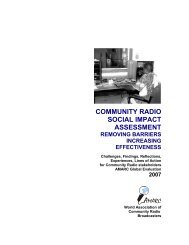Live News - A Survival Guide - International Federation of Journalists
Live News - A Survival Guide - International Federation of Journalists
Live News - A Survival Guide - International Federation of Journalists
- No tags were found...
Create successful ePaper yourself
Turn your PDF publications into a flip-book with our unique Google optimized e-Paper software.
CHAPTER 3Riots and civil disorderEven peacefulgatherings canbe dangerous<strong>News</strong>week correspondentBabak Dehghanpisheh wasreporting onthe arrival <strong>of</strong>refugees atMaslakhAfghanistan, inNovember 2001.“It was cold and people weredesperate for water. Morewere arriving every day. Mostaid agencies had not returnedyet. I had become separatedfrom other journalists.“I was talking to people in thecrowd — since I spoke Farsithey could relate to me. Thenthe crowd turned into a moband people started grabbingmy clothes, fighting to get atme. I felt panicked. Theguards beat people awaywith AKs. After half an hour Ifinally made it to the car. Iwas very scared andphysically over-powered.“I should have stayed closerto the car and tried to getindividuals to come to talk tome there. I should haveliaised with the NGOs and letthem bring someone to thecar.”■<strong>of</strong> sight and can catch the sounds. You can do interviews with participantsbefore and afterwards, but at the time you need anoverview <strong>of</strong> what is happening.During the eventIf you are part <strong>of</strong> a team, work with the team. Stay together or withdrawtogether. Withdraw too early rather than too late. If you areworking as an individual, ensure that you have good means <strong>of</strong> communicationwith someone who can get help if need be. Set up yourphone so that ‘last number redial’ is to a source <strong>of</strong> instant help.Try to keep a mental map <strong>of</strong> the main exit routes, prominentlocations, security force locations and the nearest hospital facility,and occasionally stop and check that they are still clear.If you fear film or tape will be seized, carry dud exposed film ortape in your pocket and hide your used material as soon as you takeit from the camera. If using digital equipment, have a dummy discin case you are forced to hand one over. In high-risk situations,team up with another photographer so that you can look out foreach other. You may be rivals — but you are also colleagues.If you are working alone, either as a reporter or a photographer,try to remain aware <strong>of</strong> when you are becoming the focus <strong>of</strong> acrowd, rather than just part <strong>of</strong> it. You may be at risk even if thecrowd is not hostile. Do not be tempted into taking unreasonablerisks just to obtain the same pictures or film that someone else hasalready shown.After the eventDebrief in the newsroom so that lessons are learned for the nextoccasion.Protect the integrity <strong>of</strong> your material. What is the law in yourcountry about the right <strong>of</strong> security forces to demand film andvideo material? You must understand the legal implications foryou as a journalist working within the area, region or country thatyou are operating in. What is the policy <strong>of</strong> your news organisation?If it is not possible to protect material within the country, is it possibleto set up a system so that film <strong>of</strong> civil disturbance is archivedoutside the country?Remember that your ability to do your job safely is adverselyaffected if the police are given access to your material after demonstrationsand civil unrest. You are put at serious risk, if those takingpart in a riot see you as part <strong>of</strong> the evidence gathering process.48
















